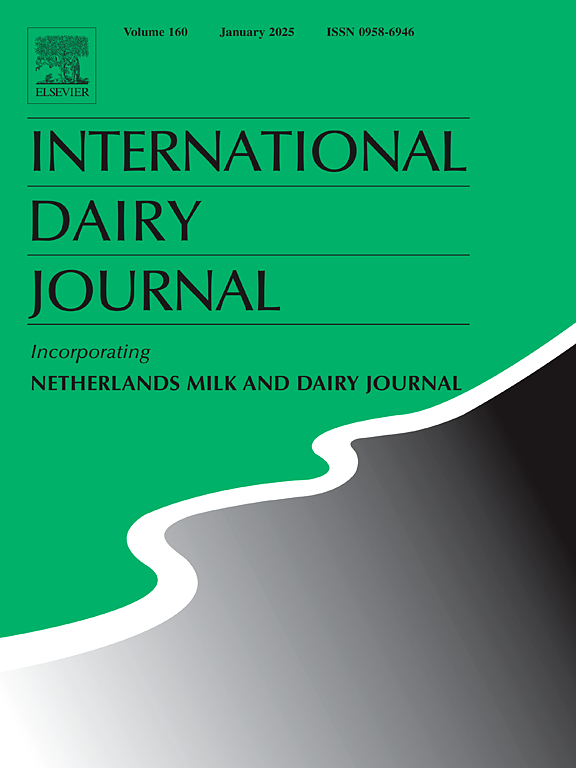Brazilian artisan white cheese (queijinho): Characterization of lactic bacteria and their physicoChemical, microbiological, and sensorial properties
IF 3.4
3区 农林科学
Q2 FOOD SCIENCE & TECHNOLOGY
引用次数: 0
Abstract
Queijinho is an artisanal cheese traditionally made from raw milk and whose know-how was brought to the Blumenau region (Brazil) by German immigrants in the mid-19th century, and to these days it is produced and marketed without control of quality criteria. This study aims to identify lactic acid bacteria and characterize the queijinho based on its physicochemical, microbiological, and sensory properties, contributing to its official registration and production regulation. Queijinho samples donated by three producers were chemically and biologically characterized, and DNA sequencing was used to identify the lactic acid bacteria. Queijinho were classified as skimmed (1.29–9.83 %) and low fat (11.04–14.35 %), based on fat matter in dry extract (FMDE), with protein content ranging from 23.09 ± 0.72 to 18.37 ± 0.86 g/100 g. Thirty-three bacterial genera were identified, particularly Streptococcus thermophilus and Streptococcus salivarius. No harmful bacteria such as Salmonella or Listeria were found, emphasizing good hygienic practices. Queijinho made from pasteurized milk showed higher chewiness (7.850 ± 1.250 N) and acceptance index (47.50 %) in the sensory analysis compared to the samples made from raw milk. The study highlights the significance of maintaining traditional practices in queijinho production, which contribute to its unique sensorial and microbiological properties.

巴西手工白奶酪(queijinho):乳酸菌及其理化、微生物学和感官特性的表征
Queijinho是一种手工奶酪,传统上由生牛奶制成,其技术在19世纪中期由德国移民带到Blumenau地区(巴西),直到今天,它的生产和销售都没有质量标准控制。本研究旨在鉴定乳酸菌,并根据其理化、微生物学和感官特性对其进行表征,为其正式注册和生产监管提供依据。对三家生产商捐赠的Queijinho样品进行了化学和生物学表征,并利用DNA测序对乳酸菌进行了鉴定。以干抽提物脂肪含量(FMDE)为标准,鸡精鱼分为脱脂(1.29 ~ 9.83%)和低脂(11.04 ~ 14.35%)两类,蛋白质含量为23.09±0.72 ~ 18.37±0.86 g/100 g。共鉴定出33种细菌属,以嗜热链球菌和唾液链球菌为主。没有发现沙门氏菌、李斯特菌等有害细菌,强调了良好的卫生习惯。巴氏奶制得的清真和的嚼劲(7.850±1.250 N)和感官接受指数(47.50%)均高于原料奶制得的清真和。该研究强调了在清真浩生产中保持传统做法的重要性,这有助于其独特的感官和微生物特性。
本文章由计算机程序翻译,如有差异,请以英文原文为准。
求助全文
约1分钟内获得全文
求助全文
来源期刊

International Dairy Journal
工程技术-食品科技
CiteScore
6.50
自引率
9.70%
发文量
200
审稿时长
49 days
期刊介绍:
The International Dairy Journal publishes significant advancements in dairy science and technology in the form of research articles and critical reviews that are of relevance to the broader international dairy community. Within this scope, research on the science and technology of milk and dairy products and the nutritional and health aspects of dairy foods are included; the journal pays particular attention to applied research and its interface with the dairy industry.
The journal''s coverage includes the following, where directly applicable to dairy science and technology:
• Chemistry and physico-chemical properties of milk constituents
• Microbiology, food safety, enzymology, biotechnology
• Processing and engineering
• Emulsion science, food structure, and texture
• Raw material quality and effect on relevant products
• Flavour and off-flavour development
• Technological functionality and applications of dairy ingredients
• Sensory and consumer sciences
• Nutrition and substantiation of human health implications of milk components or dairy products
International Dairy Journal does not publish papers related to milk production, animal health and other aspects of on-farm milk production unless there is a clear relationship to dairy technology, human health or final product quality.
 求助内容:
求助内容: 应助结果提醒方式:
应助结果提醒方式:


